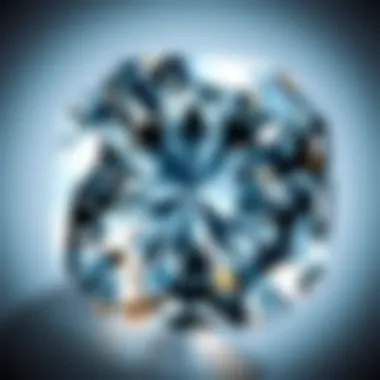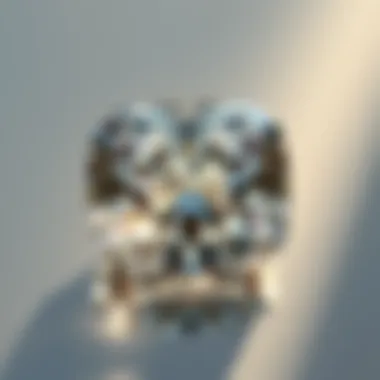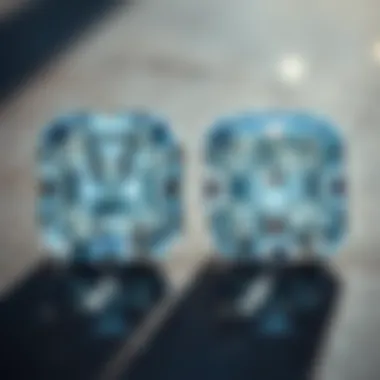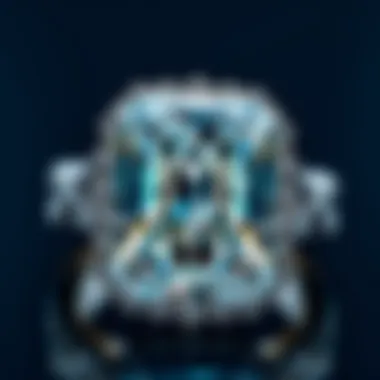Distinctions Between Asscher and Cushion Cut Diamonds


Intro
When it comes to choosing the perfect diamond, the cut often takes center stage. Not all diamonds are created equal, and two of the most captivating styles are the Asscher cut and the Cushion cut. Both cuts exhibit unique characteristics that can influence not just their visual appeal but their overall value in the market. By dissecting the nuances between the Asscher and Cushion cuts, one can truly appreciate the artistry behind these gemstones.
The Nature of Diamonds
Diamonds hold considerable allure, not just for their beauty, but for their deep-rooted significance across cultures. They have been the subject of folklore and tradition for centuries, often regarded as symbols of love, strength, and commitment. Their formation deep within the Earth's mantle, under immense pressure and heat, transforms carbon into sparkling treasures that are coveted by many.
Key Features of Asscher and Cushion Cuts
Both of these cuts feature notable differences in shape, facet design, and light performance. The Asscher cut, known for its square shape and stepped facets, reflects light with a mesmerizing brilliance that often captivates the eye. On the other hand, the Cushion cut, reminiscent of a pillow, boasts a rounded corner and a more romantic appearance, marked by its larger facets that enhance depth.
To grasp these differences fully, one must dive deeper into the histories and qualities defining both styles. Understanding how they fit into today's jewelry market also serves to appreciate their distinctive appeals among collectors and enthusiasts.
"Choosing between an Asscher and a Cushion cut is not just a decision about aesthetics; it's an investment in timeless beauty and craftsmanship."
Taking a closer look at their individual histories offers a glimpse into how each has earned its place in the annals of jewelry design. The Asscher cut emerged in the early 20th century, inspired by the Art Deco movement, while the Cushion cut has a rich history dating back to the 19th century, making it a classic choice.
As this article unfolds, we will delve into the unique features, historical backgrounds, and suitability of each cut, while underscoring important aspects such as their light performance, popularity, and care.
Prolusion to Diamond Cuts
When discussing diamonds, the cut is often regarded as one of the most vital aspects to consider. It's not merely about how sparkly a diamond is; rather, it encompasses its overall aesthetic appeal and how effectively it returns light. The specifics of a diamond's cut can significantly influence its beauty and, ultimately, its value. This makes understanding different diamond cuts a necessary jaunt for anyone interested in gemstones.
As we embark on our exploration of Asscher and Cushion cuts, we recognize that diamond cuts are not random configurations—they each tell a story steeped in history.
Understanding Diamond Cuts
At its core, diamond cutting transforms a rough stone into a gem capable of capturing people's hearts. The art of diamond cutting is not straightforward; it blends science and artistry to produce a finished product that shines with brilliance. For instance, the Asscher cut boasts a square shape with cropped corners, embracing vintage charm, while the cushion cut resembles a pillow with rounded corners, melding classic and contemporary aesthetics. Both cuts have unique faceting styles, influencing how light interacts with the stone.
Moreover, it’s not just about aesthetics; the choice of diamond cut can reflect the wearer’s personality. From the innovative angles of modern cuts to the traditional allure of more classical shapes, each cut offers a different reflection of one’s identity and values. In understanding diamond cuts, buyers can make informed decisions that resonate with their personal style and occasion.
The Importance of Cut in Diamond Quality
Cut quality plays a pivotal role in the evaluation of diamonds. Unlike clarity or color, which can be quantified, cut is more subjective, yet it significantly impacts a diamond's brilliance. A well-cut diamond will reflect light beautifully—think of it as a finely tuned instrument delivering harmonious notes.
Here are the key elements of cut that impact the overall quality:
- Proportions: The dimensions of the diamond affect how light is refracted, increasing or diminishing brilliance.
- Symmetry: Evenly shaped and aligned facets lead to maximum sparkle. Issues with symmetry can cause light to escape, leading to a less dazzling appearance.
- Polish: The surface quality can influence how well a diamond sparkles. A smooth surface allows light to pass without obstruction.
Without a doubt, understanding the nuances of diamond cuts not only equips buyers for a more rewarding purchase but also enriches their appreciation for these captivating stones. Buyers can align their preferences with the qualities of Asscher and Cushion cuts, ultimately selecting a diamond that mirrors their individual taste.
An Overview of the Asscher Cut
Understanding the Asscher cut is crucial for anyone interested in diamonds. This cut exudes a certain elegance that distinguishes it from other shapes. The Asscher cut shines in both vintage and contemporary jewelry contexts. It has a uniquely recognizable square shape along with rounded corners, making it stand out. Knowing its features can help buyers make informed choices while indulging in this splendid gemstone.


Historical Context of the Asscher Cut
The Asscher cut made its debut in the early 20th century, specifically in 1902, thanks to Joseph Asscher and his brother, which marked a significant moment in jewelry design. Initially popular in Europe, this cut reflects an art deco flair that remains adored today. In the roaring twenties, the Asscher cut gained traction among the elite and Hollywood stars, a testament to its timeless appeal.
The cut’s resurgence in modern times has been supported by a growing appreciation for vintage designs. It is historically significant, not just for its beauty, but as a reflection of a specific cultural moment in jewelry history. The Asscher cut is not just a cut; it's a representation of elegance that transcends generations.
Characteristics of Asscher Cut Diamonds
Shape and Faceting
The Asscher cut features a square shape along with a unique arrangement of facets that resemble the emerald cut but with a deeper pavilion. This design results in a mesmerizing play of light and shadow, known as the "hall of mirrors" effect. The upper facets create a depth that highlights the diamond's clarity and color, making it a fantastic choice for those searching for brilliance in a subtle way.
Notably, the sharp corners and cropped edges offer a modern twist to classic designs, which is often appealing to discerning buyers. The square shape provides a sense of balance and symmetry that enhances the diamond's overall aesthetic.
Proportions and Dimensions
In the realm of diamond cuts, proportions significantly influence the visual performance of the diamond. Asscher cuts typically have a length-to-width ratio close to 1.0, meaning they’re more square than rectangular. A well-proportioned Asscher cut is noted for its brilliance and sharp angles that catch the eye. Jewelers often assess these dimensions to ensure quality, resulting in a beautiful sparkle without losing its integrity.
The advantages of these proportions include greater light performance and a solid appearance, making it an outstanding choice for engagement rings and other fine jewelry. However, like a double-edged sword, poor proportions could lead to a dull appearance, which buyers must be cautious about during their selection.
Light Performance
Light performance is a hallmark of truly exceptional diamonds. With an Asscher cut, the light performance creates an enchanting luminescence through its complex faceting. The cut’s unique angles lead to a stunning array of reflections, which provides a captivating depth and appearance as it catches light from various angles.
An Asscher diamond that is well-cut will exhibit brilliance and fire, making it a popular pick among collectors seeking both beauty and quality. However, it’s essential for buyers to examine the diamond under different lighting conditions to evaluate its true performance.
Potential Settings for Asscher Cut Diamonds
Finding the right setting for an Asscher cut diamond can significantly enhance its appeal. Classic settings, such as a solitaire, allow the diamond to take center stage, showcasing its beauty without distraction. Vintage-inspired settings often complement the Asscher cut, enhancing its historical roots.
Additionally, halo settings emphasize its brilliance, providing a striking contrast between the diamond and surrounding petite gemstones. Selecting the right metal—whether it’s white gold, yellow gold, or platinum—also plays a part in the diamond's overall appearance. Buyers should carefully consider settings that not only enhance the cut but carry personal meaning or style to reflect the wearer's individual taste.
An Asscher cut diamond often tells a story—a blend of history, elegance, and craftsmanship.
Understanding its characteristics and the potential settings offers a clearer picture for those who appreciate the fine arts of diamond cuts.
An Overview of the Cushion Cut
The cushion cut, known widely for its soft, romantic appeal, holds a significant place in the world of diamonds. This particular cut has a history steeped in tradition and artistry, making it a favorite among diamond enthusiasts and jewelry designers alike. Its distinctive charm lies not just in its aesthetics, but also in its versatility, allowing it to fit various styles and preferences. This section aims to explore the cushion cut in depth, examining its historical significance, unique characteristics, and ideal settings.
Historical Context of the Cushion Cut
The origins of the cushion cut can be traced back to the mid-19th century. It emerged as a successor to older cuts, such as the old mine cut and the old European cut. The name "cushion" stems from the shape resembling a soft pillow, which has become a hallmark of vintage and contemporary jewelry alike. During the late 1800s and early 1900s, cushion cuts gained popularity, particularly in engagement rings, as they showcased each diamond’s sparkle with an alluring blend of brilliance and a unique flair.
Interestingly, this cut underwent several modifications over the decades, leading to a variety of cushion cuts available today. Jewelers began to experiment with the facets, which added to the dazzle and character of the stone. As trends shifted over the years, the cushion cut saw a significant resurgence in the late 2000s, becoming a beloved choice again, especially among celebrities and influencers.


Characteristics of Cushion Cut Diamonds
Shape and Faceting
The cushion cut features a square or rectangular shape with rounded corners, giving it a softer silhouette than older styles. Its faceting is typically arranged in a way that enhances its light performance. The key characteristic of the cushion cut lies in its larger culet and open culet design, allowing for a beautiful reflection of light. This design choice contributes to the diamond’s overall beauty, resulting in what many perceive as a more romantic aura compared to sharper-angled cuts.
However, it’s worth noting that the varied quality of cut can result in different light effects. Some cushions may not reflect light as efficiently, leading to a less desirable appearance. Attention to craftsmanship becomes paramount when selecting a cushion cut diamond, as an expertly cut stone can truly shine.
Proportions and Dimensions
When it comes to proportions, cushion cuts are typically set in a range of dimensions, but they generally maintain a ratio of 1:1.1 to 1.2:1. This proportion allows for both elegance and presence, making it a popular choice for those seeking an eye-catching piece. The key characteristic of proportions is that they can greatly influence how the diamond sparkles in various lighting settings. An well-proportioned cushion cut will dance with light, presenting vibrant colors and reflections.
However, if the proportions veer too far from the recommended range, the cushion cut can lose its charm, appearing overly wide or elongated. Buyers should thus be discerning, prioritizing diamonds with well-balanced dimensions for optimal appearance.
Light Performance
One of the most alluring features of cushion cut diamonds is their light performance. Though the cut is known for its warm glow, it can vary significantly dependent on the stone's clarity and color. The key characteristic of cushion cuts in terms of light performance is their square shape with rounded corners, enabling them to capture and reflect light beautifully, similar to a prism. This performance has made them a popular choice for vintage and antique-inspired designs.
On the flip side, certain variations may create what is known as a “window,” where light can pass through without reflective qualities. This downside is particularly vital for potential buyers to consider, as it emphasizes the importance of purchasing only from reputable dealers who guarantee high-quality cuts and brilliance.
Potential Settings for Cushion Cut Diamonds
Cushion cut diamonds can be set in a variety of styles, making them remarkably adaptable for any jewelry piece. Whether it be vintage halo settings, modern solitaires, or art deco designs, the cushion cut manages to harmonize with various aesthetics. Here are a few popular options:
- Halo Settings: The cushion cut pairs beautifully with a surrounding halo of smaller diamonds, enhancing its size and brightness.
- Side Stone Settings: Accompanying the cushion cut with side stones can accentuate its beauty and create a more pronounced look.
- Three-Stone Settings: This classic arrangement showcases the cushion cut's center stage while balancing it with two accent stones, symbolizing past, present, and future.
Ultimately, whether one prefers the timeless elegance of a halo setting or the sleek minimalism of a solitaire setup, the cushion cut remains a versatile option that seamlessly fits into any collection.
Comparative Analysis of Asscher and Cushion Cuts
In the realm of diamonds, the cut shapes play a pivotal role in how these stones are perceived, enhancing their beauty and allure. Understanding the distinctions between the Asscher cut and the Cushion cut goes beyond mere aesthetics; it delves into the very essence of diamond craftsmanship. This comparative analysis aims to illuminate the unique attributes of each diamond cut, shedding light on why a prospective buyer may choose one over the other. Factors such as visual appeal, popularity, and pricing dynamics are intricately woven into the narrative, making it a key focal area of this article.
Visual Differences and Aesthetics
The visual presentation of both Asscher and Cushion cuts is where the magic truly lies. Asscher cut diamonds, characterized by their square shape and cropped corners, exhibit a distinctive art deco feel. Their pavilion is designed to create a unique light performance, leading to a mesmerizing play of light and shadow. This cut tends to manifest a "hall of mirrors" effect which can make it seem more dynamic than its cushion counterpart.
On the flip side, Cushion cut diamonds showcase a softer, rounder silhouette with rounded corners and larger facets. This diamond shape captures light differently, often leading to a romantic, almost vintage allure. The contrast in their appearances is stark; where Asscher cuts lean towards elegance and precision, Cushion cuts are all about warmth and charm. For a buyer wanting a classic ring with a touch of modernity, the choice between these two could hinge on the specific visual preference—whether one is inclined towards sophistication or embracing a more classic look.
Popularity Among Jewelers and Consumers
When it comes to market trends, popular opinion often sways the tides of choice. Asscher cuts, although less commonly seen than their cushion counterparts, have carved a niche within certain circles. They attract those who appreciate vintage designs and the geometric allure of a well-cut diamond. Their rarity can imbue a piece with an air of exclusivity, appealing to collectors who seek something out of the ordinary.
Cushion cuts, however, hold a firm position in the hearts of many, especially seeing a resurgence in recent years. Their ability to showcase color and brilliance effectively attracts consumers who desire a classic stone that appears elegant in various jewelry styles. Jewelers frequently recommend cushion cuts for engagement rings due to their historical significance and broad appeal. The popularity of these cuts might also be swayed by celebrity choices that shine a spotlight on their beauty and charm.
Pricing Considerations


Regarding pricing, the dynamics can get a bit intricate. Asscher cut diamonds often command a premium due to their intricate cutting process and lower production volume. The precision required to create the perfect Asscher cut means that they can be a bit pricier per carat than their Cushion cut counterparts. Consumers need to weigh the value of unique craftsmanship against their budget.
Cushion cuts usually fall within a broader price range. This price difference can be attributed to the wider availability of Cushion cut diamonds since they are produced in larger quantities. Therefore, buyers may find more options in various price brackets, allowing them to select a diamond that suits their financial strategies without compromising on quality.
Ultimately, understanding these facets—pun intended—between Asscher and Cushion cuts can empower consumers, enabling informed decisions tailored to individual preferences and financial situations. As the landscape of diamond purchasing evolves, staying attuned to these distinctions remains crucial.
Practical Considerations for Buyers
When it comes to buying diamonds, the distinctions between Asscher cut and Cushion cut play a pivotal role in making an informed decision. Understanding what each cut offers not only aids in selecting the right piece but also ensures that you’re aware of practical aspects that can affect your purchase down the line. The right choice isn’t just about aesthetics; it also involves considerations like maintenance, potential resale value, and the overall longevity of the diamond.
Choosing Between Asscher and Cushion Cuts
Deciding whether to go with an Asscher or Cushion cut involves delving deeper than mere appearances. Each cut comes with its own flair – Asscher cut lights up like a princess at a ball, whereas Cushion cut often showcases a classic, vintage vibe. Here are some points to mull over:
- Aesthetics: Think about the personality of the person who will be wearing the diamond. Do they lean toward contemporary styles or are they more into vintage aesthetics?
- Setting Compatibility: Different cuts may be better suited for certain ring designs. Do you plan on setting the diamond in a simple band or something more intricate?
- Budget: Understand the pricing dynamics. Generally, Asscher cuts may be on the pricier side due to their intricacy, while Cushion cuts can offer more flexibility.
- Wearability: Consider the lifestyle of the wearer. Cushion cuts can be more versatile for daily wear, while Asscher cuts might be best saved for special occasions.
Maintaining Your Asscher and Cushion Cut Diamonds
Caring for your Asscher and Cushion cut diamonds is essential to keep them looking their best. Both cuts have unique characteristics that may affect how they should be maintained:
- Regular Cleaning: Use a gentle cleaning solution and a soft brush to get rid of dirt. For an Asscher cut, be careful with the corners, as dirt can accumulate there. For a Cushion cut, ensure you're inspecting the facets to keep them sparkling.
- Professional Cleaning: Schedule a cleaning with a jeweler occasionally. They can inspect the setting, ensuring the stone is secure.
- Safe Storage: When not being worn, store your diamonds in a soft pouch or a separate compartment in your jewelry box to avoid scratches.
Resale Value and Longevity
Thinking about the future is wise when investing in diamonds. The resale value of Asscher and Cushion cut diamonds can fluctuate based on trends and market conditions:
- Market Demand: Currently, Cushion cuts have captured a sizable share of the market, mainly due to their romantic aesthetic. This might enhance their resale value down the road.
- Quality Factors: Resale relies on the quality of the cut and clarity. A well-cut Asscher with good clarity may retain its value better than a poorly cut Cushion.
- Longevity Potential: Diamonds are forever, but the settings matter too. A well-maintained setting can enhance longevity, reducing potential issues down the line.
"When you invest in a diamond, you’re not just buying a piece of jewelry; you're securing a story, a legacy that can be passed down."
Whether you are enchanted by the bold, geometric lines of an Asscher cut or drawn to the romantic allure of a Cushion cut, understanding these practical aspects will enhance your buying experience and ensure that you choose a diamond that not only looks good but also stands the test of time.
Ending
When deliberating over diamond cuts, arriving at a decision carries weighty implications not just for aesthetics, but for investment, wearability, and personal expression. This article meticulously dissected the unique attributes of Asscher and Cushion cut diamonds, steering readers through not only their historical significance but also their practical applications in jewelry design.
Summarizing Key Differences
To distill what we have explored:
- Shape and Faceting: The Asscher cut embodies a square shape with cropped corners, showcasing an octagonal form that can create a mesmerizing depth. In contrast, the Cushion cut has a rounded shape, often likened to a pillow, exuding a vintage charm with its softer curves.
- Light Performance: Both cuts dazzle in their own right, but they do so differently. The Asscher, with its precise angles, attracts light in a controlled, elegant manner, while the Cushion cut tends to radiate a more romantic and sparkling glow, appealing to those who fancy a softer shimmer.
- Popularity and Settings: Asscher cuts are often favored in more modern, elegant settings—think sleek platinum or white gold. Meanwhile, Cushion cuts can fit into a variety of styles, from the classic solitaire to more elaborate arrangements, allowing for versatility in choice of settings.
- Market Value: Importantly, the pricing can vary based on demand and market trends, with Cushion cuts often being more readily available and Asscher cuts sometimes demanding a premium due to their unique appeal.
As seen from the analysis above, choosing between an Asscher and a Cushion cut diamond is not merely an exercise in aesthetics but a reflection of one’s taste, lifestyle, and even sentiment.
Final Thoughts on Cut Selection
Choosing the right cut involves careful consideration. Personal preference reigns supreme; after all, the diamond you wear should resonate with your style and commemorate significant moments. When making your choice:
- Consider Your Lifestyle: If you lead an active life, both cuts can hold up well, but think about the setting that will best suit your daily activity. A lower-set Asscher might cater to practicality, while a high-set Cushion could catch on clothing.
- Reflect on Emotional Value: Diamonds symbolize profound moments; think about what resonates with you—does the historical gravitas of an Asscher or the classic warmth of a Cushion appeal more?
- Seek Expert Guidance: Consulting with jewelers and examining various settings can facilitate a well-rounded decision. Don't shy away from learning—applying knowledge from this article can provide better insight into what truly dazzles your eye.
In closing, whether you lean toward the sharp angles of an Asscher cut or the soft curves of a Cushion, each choice carries distinct elements of beauty and individuality. The tale of these diamonds is as timeless as the stones themselves, echoing sentiments through ages past and into the future.







